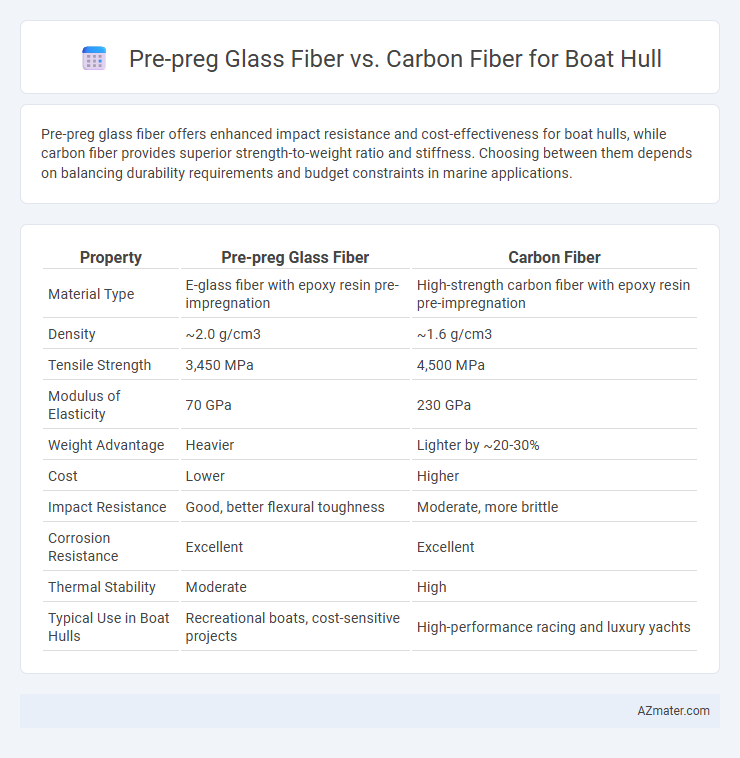Pre-preg glass fiber offers enhanced impact resistance and cost-effectiveness for boat hulls, while carbon fiber provides superior strength-to-weight ratio and stiffness. Choosing between them depends on balancing durability requirements and budget constraints in marine applications.
Table of Comparison
| Property | Pre-preg Glass Fiber | Carbon Fiber |
|---|---|---|
| Material Type | E-glass fiber with epoxy resin pre-impregnation | High-strength carbon fiber with epoxy resin pre-impregnation |
| Density | ~2.0 g/cm3 | ~1.6 g/cm3 |
| Tensile Strength | 3,450 MPa | 4,500 MPa |
| Modulus of Elasticity | 70 GPa | 230 GPa |
| Weight Advantage | Heavier | Lighter by ~20-30% |
| Cost | Lower | Higher |
| Impact Resistance | Good, better flexural toughness | Moderate, more brittle |
| Corrosion Resistance | Excellent | Excellent |
| Thermal Stability | Moderate | High |
| Typical Use in Boat Hulls | Recreational boats, cost-sensitive projects | High-performance racing and luxury yachts |
Introduction to Pre-preg Glass Fiber and Carbon Fiber
Pre-preg glass fiber and carbon fiber are composite materials widely used in boat hull construction for their superior strength-to-weight ratios and durability. Pre-preg glass fiber consists of fiberglass fabric pre-impregnated with resin, offering excellent impact resistance and cost-effectiveness, ideal for hulls requiring flexibility and toughness. Carbon fiber pre-pregs provide exceptional stiffness, high tensile strength, and reduced weight, making them preferable for high-performance boats demanding enhanced speed and structural integrity.
Material Composition and Manufacturing Process
Pre-preg glass fiber for boat hulls consists of woven fiberglass fabrics pre-impregnated with a precise resin matrix, typically epoxy, ensuring consistent resin-to-fiber ratio and reducing voids during curing. Carbon fiber pre-pregs feature ultra-high tensile strength carbon filaments combined with advanced epoxy systems that offer superior stiffness and weight reduction compared to glass fibers. The manufacturing process for both materials involves controlled curing under heat and pressure in an autoclave or vacuum bagging, but carbon fiber requires more stringent temperature controls due to its sensitivity and higher material cost.
Strength and Durability Comparison
Pre-preg glass fiber offers excellent impact resistance and flexibility, making it highly durable for absorbing shocks and vibrations in boat hull construction. Carbon fiber provides superior tensile strength and stiffness, resulting in a lighter and more rigid hull that enhances performance and fuel efficiency. While carbon fiber excels in strength-to-weight ratio, pre-preg glass fiber delivers greater toughness against fatigue and long-term wear.
Weight and Performance Impact
Pre-preg carbon fiber offers superior strength-to-weight ratio compared to pre-preg glass fiber, significantly reducing boat hull weight and enhancing speed and fuel efficiency. Carbon fiber's high stiffness improves hull rigidity, resulting in better handling and performance under dynamic marine conditions. While glass fiber is more cost-effective and provides good impact resistance, its heavier weight decreases acceleration and maneuverability in high-performance boats.
Cost Analysis: Upfront and Long-term
Pre-preg glass fiber offers a lower upfront cost compared to carbon fiber, making it more accessible for budget-conscious boat hull projects. While carbon fiber demands a higher initial investment, its superior strength-to-weight ratio provides long-term savings through improved fuel efficiency and reduced maintenance. Over the vessel's lifecycle, carbon fiber's durability and performance benefits often offset the initial expense, resulting in a more cost-effective solution for high-performance marine applications.
Resistance to Environmental Factors
Pre-preg carbon fiber exhibits superior resistance to environmental factors such as UV radiation, moisture ingress, and chemical exposure compared to pre-preg glass fiber, making it highly suitable for harsh marine environments. Glass fiber, while more cost-effective, is prone to water absorption and may experience degradation over time when exposed to saltwater and temperature fluctuations. Enhanced durability and reduced maintenance requirements often justify the higher upfront cost of pre-preg carbon fiber in boat hull applications.
Maintenance Requirements and Longevity
Pre-preg glass fiber boat hulls exhibit superior corrosion resistance and easier repair processes, resulting in lower maintenance efforts over time compared to carbon fiber options. Carbon fiber offers higher strength-to-weight ratios but requires meticulous inspection and specialized repair techniques to prevent delamination and structural degradation. The longevity of pre-preg glass fiber hulls is often extended due to their resilience against environmental damage, whereas carbon fiber hulls can achieve longer service life only with consistent, advanced maintenance protocols.
Suitability for Various Boat Types
Pre-preg carbon fiber offers superior strength-to-weight ratios and stiffness, making it ideal for high-performance racing boats and lightweight speedboats where weight reduction and rigidity are critical. Pre-preg glass fiber provides excellent impact resistance and cost-effectiveness, suitable for larger recreational, fishing, and cruising boats that prioritize durability and budget. Selection depends on specific boat type requirements, balancing factors like structural demands, cost, and weight efficiency.
Sustainability and Environmental Considerations
Pre-preg glass fiber offers a more sustainable option for boat hulls due to its lower carbon footprint and easier recyclability compared to pre-preg carbon fiber, which is energy-intensive to produce and difficult to recycle. Glass fiber composites utilize abundant natural silica, reducing environmental impact, while carbon fiber production emits significantly higher CO2 and involves non-renewable resources. Selecting pre-preg glass fiber enhances eco-friendly marine manufacturing by minimizing toxic resin use and facilitating end-of-life material recovery.
Choosing the Right Material for Your Boat Hull
Pre-preg carbon fiber offers superior strength-to-weight ratio and stiffness compared to pre-preg glass fiber, making it ideal for high-performance boat hulls where weight reduction and durability are critical. Pre-preg glass fiber provides better impact resistance and is more cost-effective, suitable for recreational boats or applications where budget constraints exist. Selecting the right material depends on factors like desired performance, budget, and specific environmental exposure, with carbon fiber favoring racing and high-end builds, while glass fiber suits general use and maintenance ease.

Infographic: Pre-preg Glass Fiber vs Carbon Fiber for Boat Hull
 azmater.com
azmater.com